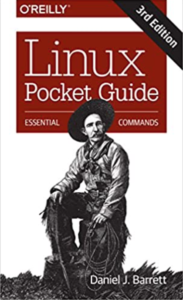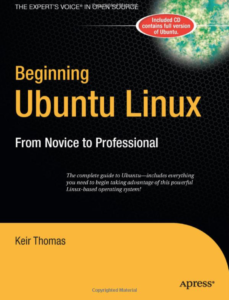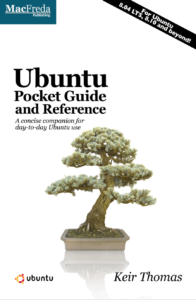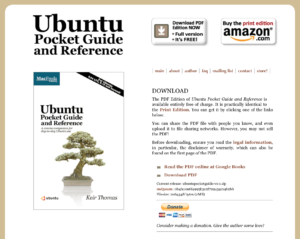TL;DR Ubuntu Pocket Guide and Reference has been downloaded/accessed over 600,000 times since it launched back in 2009 according to my measures. But the real figure is more likely to be 1,000,000+. This makes it one of the most successful computing textbooks of all time. Here’s the story of how it came into existence. /TL;DR
I was walking around a Linux trade fair in 2004. You know what these place are like. Some stands are incredibly noisy. Videos on huge screens! Attractive people hired by the day! Free stress balls in a fruit bowl!

Some stands are really quiet, with just a few people behind a desk.
It was from one of these that a very tall and friendly chap approached me.
“Would you like to write a book about Linux?”, he asked.
I was editing a computer magazine called Linux User and Developer. It was right there on my lanyard badge. So, I suppose the question made sense.
And as it happened, yes, I had indeed been thinking about writing a book about Linux.
Linux was hot back then. IBM had invested millions in it. Although already a few decades old, it was considered nascent technology. On the rise. Everybody wanted to learn about it.
And so I wrote a book about Linux, with the aforementioned chap as the editor. He worked for a publisher called Apress.
Within a few years, I’d published several more Linux textbooks.

And then I worked a short stint as a commissioning editor for Apress. This provided access to the Nielsen BookScan data. Using this, I could see what books had sold well for competitors.
I found one book in particular intriguing: Linux Pocket Guide, published by O’Reilly and written by Daniel J Barrett.
This had sold stunningly well compared to every other computer textbook. This was perhaps because it was half the price of them, due to its size. It really was a small book intended for storing in the pocket.
Computer textbooks sell by weight. Not literally. But people pay high prices for 1,000+ page tomes that break your toes if you drop them.
This is a fundamental truth about the industry.
Linux Pocket Guide broke this rule. And gave me an idea.
Do the same – but with Ubuntu

One of my books for Apress, published in 2006, was called Beginning Ubuntu Linux.
It was only the second book about Ubuntu ever published, and the first in English. It would go on to sell incredibly well, win a Linux Journal award, and go through many updated editions.
Ubuntu Linux was a phenomenon. Infamously backed by a South African millionaire, at that point in its history it aimed to bring Linux to the desktop.
My idea was simple: O’Reilly should publish Ubuntu Pocket Guide. And I would write it.
I attracted the interest of one of O’Reilly’s editors. We polished-up the idea until it was surely a slam-dunk. The editor took it to O’Reilly’s big proposal discussion meetings and…
They said no.
The problem was the low price of the book. High sales volume would be needed, and they didn’t believe the book would achieve that.
In hindsight, I’m unsure they comprehended the tsunami that was Ubuntu. It wasn’t just another version of Linux. It was creating its own movement in the world of open source software.
I approached a few other contacts in the industry, but they declined too. It was down to that size and format issue. Computer books sell because of their weight!
So, I decided to go it alone.
I would do it myself.

Having the experience of both a textbook author and a commissioning editor, I certainly had the skills. And the boom in self-publishing platforms like Amazon’s CreateSpace had democratised publishing. Anybody could get an Amazon product page!
I recruited a couple of folks who ran the poplar Ubuntu Forums website to help review the book for technical errors, along with an old friend who had edited Linux Magazine.
From inception to publication, it took about four months to get Ubuntu Pocket Guide and Reference out there.
There was just one problem. And it was a biggie.
How to market a computer textbook
There isn’t a whole lot of marketing involved with computer textbooks. It’s mostly organic.
More often than not, a given book from a publisher sells to a dedicated readership who appreciate that publisher’s takes on technology, or even their attitude towards life in general.
If you bought an O’Reilly book on, say, databases, then you could expect their book on a programming language is of the same level of quality. So you’d buy that too without hesitating.
Because I was self-publishing, I didn’t have access to any brand loyalty. As an author I’d had success but nobody really knew who I was.
Books are launched and sink without trace every second of every day, regardless of how great they are.
This is the one thing that people outside of publishing just never understand. Getting eyeballs on a new project is difficult to the point of virtually impossible.
I asked around for marketing ideas that were cheap, as in free.
I heard about another computer textbook author who, after publishing his book, had converted the entire book into a website. This was free to access. He said this had worked very well for him in terms of driving sales of the print edition.

So, I created a plan. I would give away the eBook version of Ubuntu Pocket Guide and Reference. It would be a free PDF download from the book’s website. People could even share it as a BitTorrent, provided it wasn’t modified.
Meanwhile, the print edition would be sold through Amazon and bookstores worldwide.
Print books were still dominant back then. The first Amazon Kindle had been launched two years earlier, but was still a niche product limited to enthusiasts. eBooks were largely considered a novel concept.
My theory was that people would like the book so much that they would also want a hard copy to keep on their desk. At around $12, this wouldn’t break the bank.
Did it work?
Hmmm.
I mentioned earlier that Ubuntu was a tsunami.
Everybody in the world of open source had seen the massive wave approaching from miles away. My earlier books about Ubuntu, mentioned earlier, proved it was an extraordinary occurrence.
And I rode that tsunami in a big way with Ubuntu Pocket Guide and Reference.
In fact, I’m pretty sure that by offering a high-quality free eBook from an experienced author, I can claim a small amount of credit for the early success of the Ubuntu project. All projects need high quality documentation. I provided that for beginners.
The Ubuntu Forum people used to email people about the eBook when they registered, for example. Countless websites listed it as a resource.
My book became many people’s first experience of getting to know Ubuntu, proving more popular even than the officially-licensed book.
Pretty soon, Google Analytics showed the book’s website getting thousands of visitors a day. The page views went astronomical if the book got featured somewhere popular, like Slashdot. Because there wasn’t much else at the book’s site, I had to assume all the visitors were downloading the eBook.
I tallied-up the page view count at one point, not long after the book launched, and it was over one million.
How many people have downloaded the book?
In June 2020, I decided to count, using all the available data. This was complicated by the many ways I offered the PDF for download to avoid the site being taken offline by the sheer volume of requests:
- Amazon AWS Simple Storage Service: I have figures for this.
- Direct downloads from the website: I’m missing some server log files from the book’s website. I have logs from the book’s launch in 2009, to 2011. Then there’s a gap of five years, before the logs pick up again from 2016 to 2020. Because the PDF is just over 2MB, and nothing else on the site is, I can accurately measure book downloads by looking at downloads for files of that size.
- Content distribution network (CDN) and file hosting: I rather cheekily used the Coral Content Distribution Network (CDN), drop.io file sharing service, and even Google Sites to offload downloads of the PDF from my web server. Plus, the book was shared using BitTorrent too (with my permission). But I have no data for any of this. This is a critical lack of data. I offered the Coral CDN link as the first option in the download links section for many years!
- Google Books: I uploaded the book for reading online at Google Books. I have data for the period between 2009 and 2016.
- [EDIT ADDED IN JAN 2023] Issuu: I remembered just recently that, in 2015, I offered the book for to read for free on the Issuu publishing platform. Alas, Issuu locks away analytics data behind a paywall, and I’m not prepared to pay (plus, I’m unsure they will have historical data going back that far in any event). But Ubuntu Pocket Guide was certainly read a high number of times on this website, too.
And the final figure is…
613,129.
That’s total downloads, plus actual book views on Google Books, until June 2020. It’s a rough and ready reckoning, erring on the side of caution in the calculations. But it’s in the right ballpark, and there’s no guesswork involved. This is from cold, hard figures.
Yet I believe this figure would be higher if I could count downloads from the CDN/file hosting, and include the missing server log data. In other words, in my opinion it’s more like 1,000,000 downloads. But I can’t prove this. So, just over 600,000 is all I can legitimately claim.
Still, that’s not bad. Computer textbooks rarely get above 10,000 sales.
But what about those actual sales figures for the print edition?
Well, that didn’t go so great.
I guestimate that in the 12 years since publication the book’s paid me around a third of what I got from my other textbooks in terms of royalties.
I split out sections of the book into some smaller eBooks for sale on Amazon, which have also made money. But I can’t call the book a success from the perspective of print publishing.
Lessons learned
Some have said I was foolish to offer the eBook as a free download. But hindsight is always 20/20 and, in any event, I think they’re wrong.
As I mentioned, this was the only method I had to get the book noticed by people. It really is that simple.
Some people have suggested that I should’ve put only excerpts on the website. I don’t believe this would have been sufficient to get the book noticed by people.
Who would bother to click through to the book’s site if I just put one or two chapters online? Where’s the value in that? Who would bother sharing that with others?
And sharing is what provided those 600,000+ downloads and views. It was purely organic.
There are two things I would do differently in hindsight.
The first is to put the book online as a website, like that other guy had done, rather than offering it as a free PDF download. This would’ve created a value proposition for readers around convenience.
It’s not a great experience working your way through a website to read info. By offering the exact same PDF as had been used to print the book, I made the eBook too convenient. There was no need for readers to buy the print edition.
The second thing would’ve been to be louder about the book’s success at the time. I’m British, and reserved, and I don’t think this helped. I should’ve shouted from the rooftop about how hundreds of thousands of people were downloading the book. I should’ve informed journalists, and bloggers.
The book’s website is now old and out of date, although the basic info about commands is still useful. The site gets around 100 visitors each week. I’ve only kept it going until now to avoid a scammer buying the domain and maliciously redirecting.
Sometimes I think about doing a second edition of Ubuntu Pocket Guide and Reference. But writing is what I do for a living. I’d need to make money out of it to justify the time spent doing so.
I did approach the O’Reilly editor again once the book was a success to see if O’Reilly would change its mind for an updated version. Although I got a typically friendly response, ultimately it was another nope, alas. I also approached a contact I had at the company behind Ubuntu, Canonical, to see if Canonical was interested in adopting an updated version as an official part of the Ubuntu project. Again, it was a “no thanks”. (Note that the book is not open source; it’s copyright, just like any other mainstream book.)
We’ve all moved on in any event. Canonical is now more about enterprise cloud computing, rather than the desktop. And I last wrote a textbook in 2014, after moving into writing about Apple hardware like iPhones and Macs. I still get tiny amounts of royalties every now and again from Apress for those Ubuntu books, despite over a decade having passed.
I’m very proud of Ubuntu Pocket Guide and Reference. Even though I didn’t make a lot of money, I’m overjoyed I was able to help so many people, and that I was a part of the Ubuntu success story. Few other authors can claim their work has been accessed by hundreds of thousands of people, regardless of what they’re writing about.
My goal as a writer is pure and simple: Help people, and give them things they need. I try hard to get paid when doing this. Sometimes that doesn’t happen. And that’s fine.
If you like this story and want to show your thanks, I invite contributions via Bitcoin:
Receive BTC:
Segwit: bc1qphlmmwv9de5s9ljqvmnd6ea7kfygch4a8sh0es
Legacy: 1AbRPDdBDDLvHggs19pjPn93L7Y6msxugZ
Update March 2024
Well, I knew the day would come. I’ve taken the Ubuntu Pocket Guide site offline, after… [counts on fingers] 15 years. Maybe almost exactly 15 years, in fact, although this wasn’t intentional.
The license agreement still stands, and this means the book can still be found offered online in various places for legitimate download. The print edition is now officially out of print but you’ll still find people selling it here and there. The license agreement hasn’t changed, by the way, so please do not think the book is now abandonware or that it’s copyright-free.
Why take it offline at all? Well, although the site was mostly static HTML, it still acted as a doorway for a few drive-by hacks over the years, proving attackers with access to my entire server space. Furthermore, the site increasingly fell foul of most Google demands. It didn’t have a mobile viewport, or responsive design, for example. It used the old (old!) analytics. I don’t think it had a cookie opt-in/out, although I’m not even sure it had cookies…
Web hosting was also becoming expensive. Dreamhost weren’t exactly trying hard to keep me as a customer. It would be much cheaper for me to have a basic account, hosting a single website (the one you are currently viewing!).
The above is true of all the sites I run, in fact, including Mac Kung Fu, the Apple tips blog that I had some success with about a decade ago. I’ve decided to take that offline for the same reason. Maintaining any kind of popular site nowadays is difficult, time consuming and not cheap. The innocence of the old days of web site creation has long gone.
Will I ever go back to textbook authoring? To be blunt, the last time I looked into it—maybe around 10 years ago—I just couldn’t make it pay. Most companies weren’t even offering advances, or were offering token amounts that didn’t cover a day’s work, never mind the months it would take to write the book. It was possible to make it work if you churned out books at the rate of several each year, and then updated them just as frequently. But I noticed that those who did this still had a daytime job. It seemed to me that most computing textbooks were written by people aiming to further their career. They could say that they had literally “written the book” about that topic. I can see how that was useful, but it had no value to me as a jobbing writer and author.
It’s all a long way from the days when, as a textbook editor back in the late 00s, I worked with authors whose textbooks had funded house purchases.
But, I suppose, one should never say never. Right now, though, the Ubuntu Pocket Guide and Reference project I started in 2009 has finally come to an end. RIP little book.
